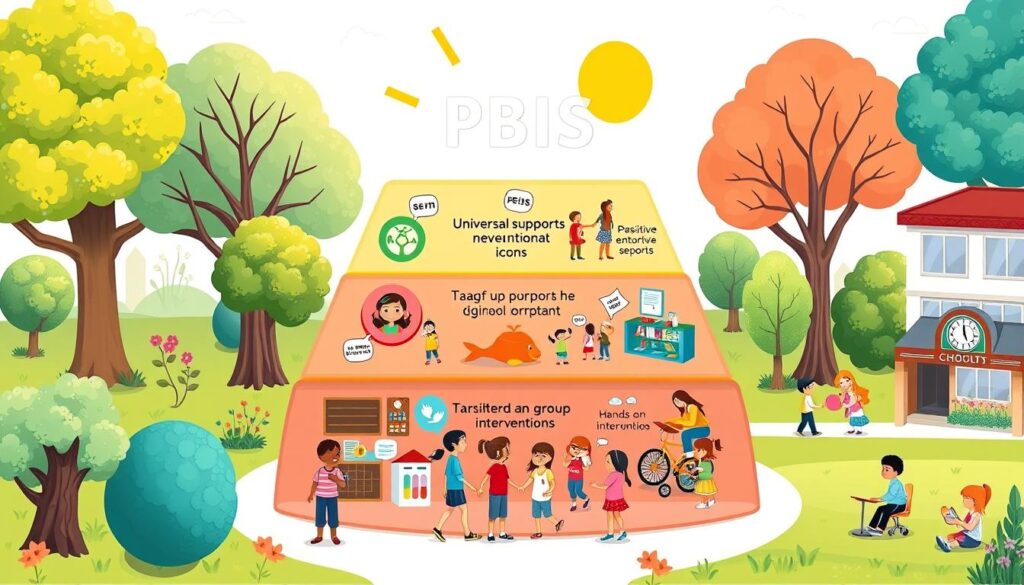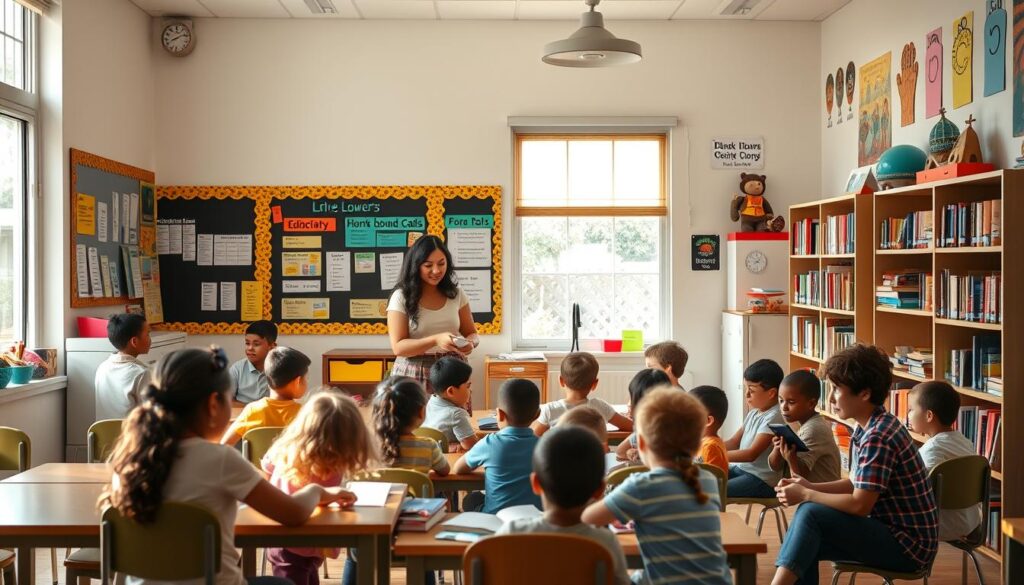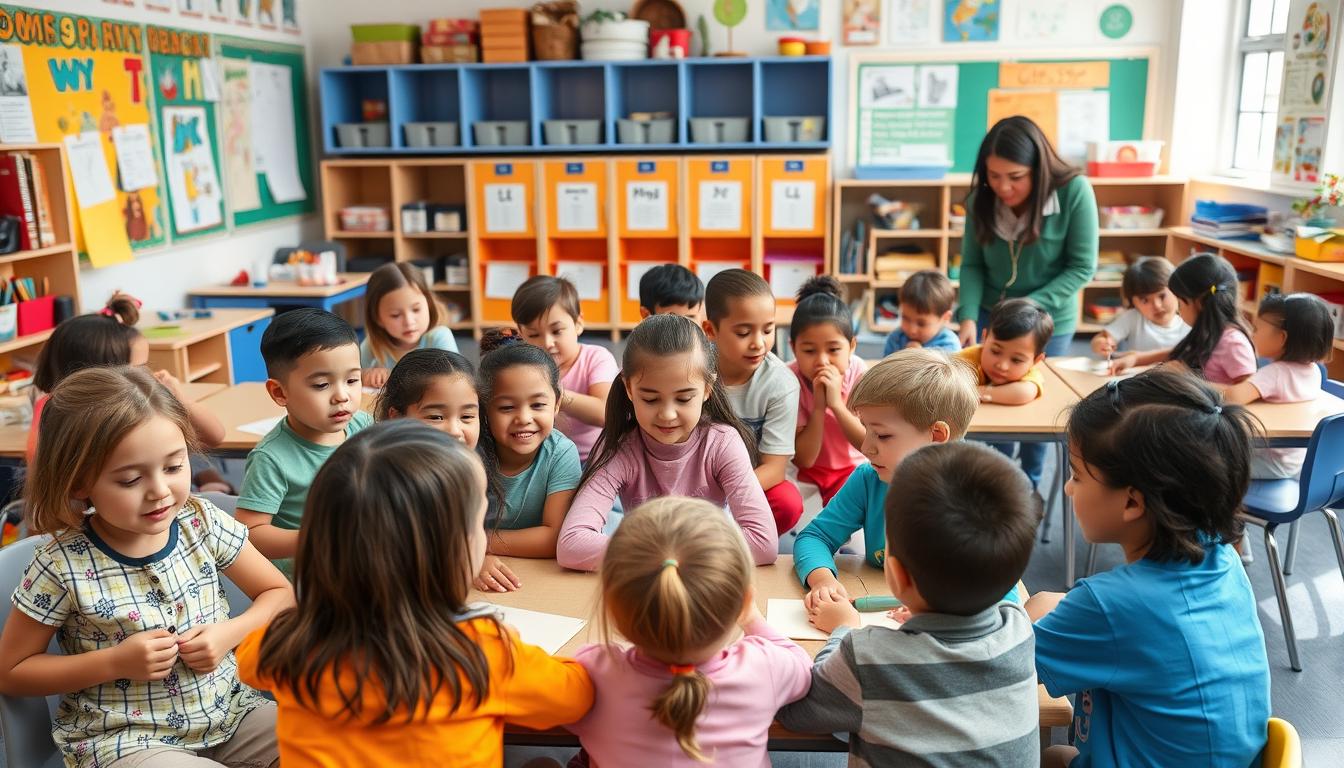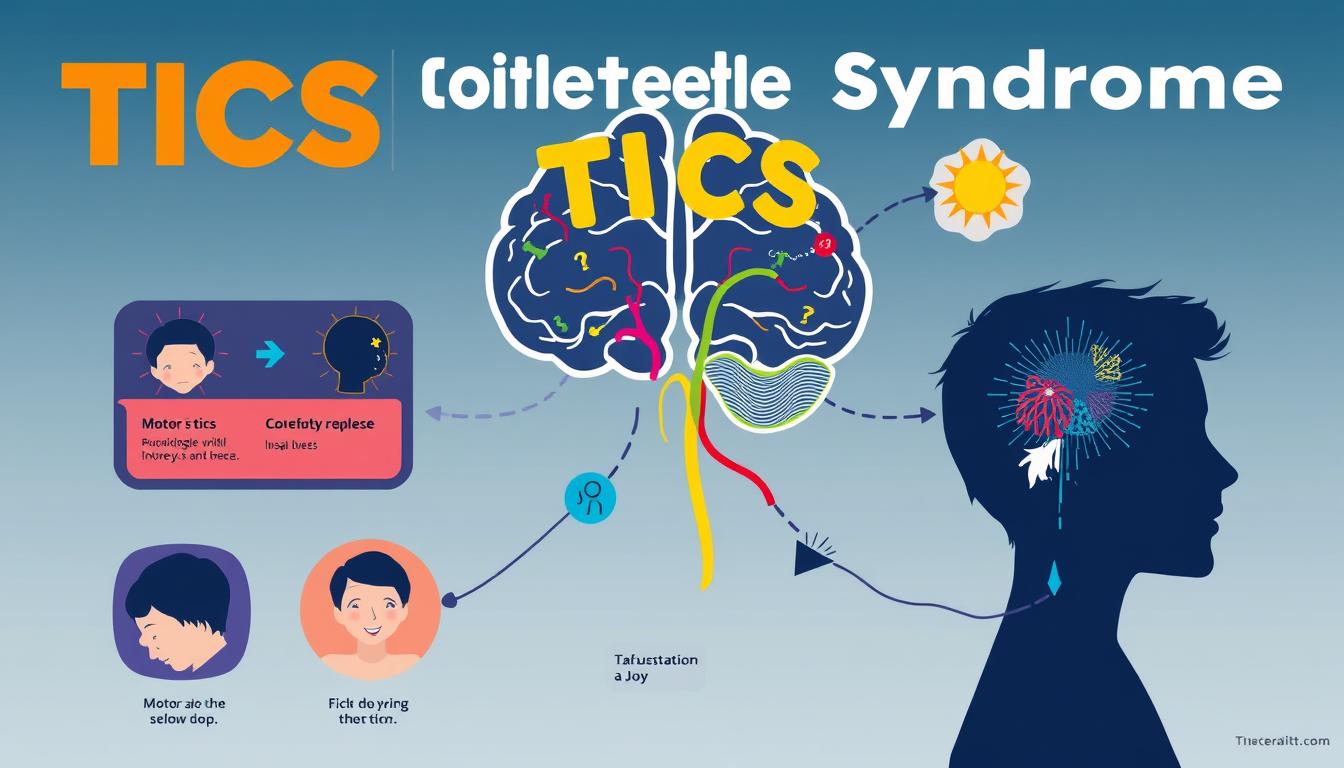As an educator, you shape the lives of young learners. You ensure they have the tools and support for academic and social success. This includes helping them overcome behavioral challenges that can hold them back.
In this guide, we’ll look at school-based interventions for kids’ behavioral issues. You’ll learn about common challenges in schools, how behavioral problems affect learning, and the need for early help. We’ll also cover Positive Behavior Interventions and Supports (PBIS), classroom management, social-emotional learning, and trauma-informed practices.
Key Takeaways
- Understand the common behavioral challenges faced in educational settings and their impact on student learning
- Explore the importance of early identification and intervention to address behavioral issues
- Learn about the Positive Behavior Interventions and Supports (PBIS) framework and its role in creating a positive school climate
- Discover effective classroom management strategies, such as structured learning environments and positive reinforcement techniques
- Understand the significance of social-emotional learning in building essential life skills for students
- Explore trauma-informed practices and their importance in creating safe and supportive learning spaces
- Recognize the value of strong parent-teacher partnerships in achieving behavioral success for students
Understanding School-Based Interventions for Addressing Behavioral Issues in Children
In the world of education, teachers often face challenges with behavioral issues. These issues can affect a child’s learning and social skills. Problems like disruptive behavior, attention issues, and social difficulties can make it hard for students to do well in school.
Common Behavioral Challenges in Educational Settings
Behavioral issues in schools can include:
- Disruptive behavior, such as excessive talking, acting out, or defiance
- Attention problems, like difficulty focusing or hyperactivity
- Social difficulties, including problems with peer relationships or communication skills
These challenges can be tough for teachers and students. They can affect a child’s learning and personal growth.
Impact of Behavioral Issues on Academic Performance
Behavioral problems can hurt a student’s grades. Disruptive behavior can mess up the classroom. Attention issues can make it hard to learn and do homework. Social problems can make it hard to work with others.
The Role of Early Identification
Spotting behavioral issues early is crucial. Teachers and school leaders can use classroom management strategies and early intervention programs. This helps students learn the skills they need to succeed.
“The earlier we can identify and address behavioral issues in children, the better the long-term outcomes for their academic and social development.”
Understanding behavioral challenges and the need for early help is key. Educators can then support students better. This creates a learning environment where everyone can grow and succeed.
The Foundation of Positive Behavior Interventions and Supports (PBIS)
Creating a positive learning environment is key for student success. This is where Positive Behavior Interventions and Supports (PBIS) plays a big role. PBIS is a proactive method that supports good behavior and a positive school culture.
At the heart of PBIS are a few main ideas:
- Clear and consistent behavioral expectations
- Positive reinforcement for good behaviors
- Data-driven decisions to tackle behavioral issues
By following these ideas, schools can foster a culture that rewards positive behavior modification techniques. This leads to better grades and emotional well-being for students.
One key aspect of PBIS is its focus on prevention. It doesn’t just deal with problems after they happen. Instead, it teaches and rewards good behaviors. This helps students grow into well-adjusted individuals.
“PBIS is not a curriculum, intervention, or practice, but a framework for assisting school personnel in adopting and organizing evidence-based behavioral interventions into an integrated continuum that enhances academic and social behavior outcomes for all students.”
By adopting the PBIS framework, schools can build a supportive atmosphere. This environment helps students develop important social, emotional, and behavioral skills. This approach is at the heart of effective education.

Implementing Effective Classroom Management Strategies
Effective classroom management is key to a successful learning space. Teachers can make classrooms structured and positive by using proven strategies. This section will cover important ways to manage classrooms and change student behavior.
Creating Structured Learning Environments
Having a well-organized classroom is crucial for student behavior. Start by setting clear rules for routines and transitions. Use visual aids like schedules and classroom rules to help remember these rules.
Keeping a daily routine helps students feel safe and involved in learning.
Establishing Clear Behavioral Expectations
It’s important to clearly state and enforce classroom rules. Work with students to make rules that encourage respect, responsibility, and safety. Make sure these rules are clear, suitable for their age, and explained well to everyone.
Regularly go over and remind students of these rules to keep the classroom positive and productive.
Using Positive Reinforcement Techniques
Positive reinforcement is a great way to improve student behavior. Praise students for good actions like following instructions or helping others. Use rewards like stickers or points to encourage positive behavior.
By focusing on the good, teachers can motivate students to do their best.
| Classroom Management Strategies | Behavior Modification Techniques |
|---|---|
|
|

Using these classroom management and behavior modification strategies helps teachers create a supportive learning environment. A well-managed classroom is essential for effective teaching and learning.
Social-Emotional Learning: Building Essential Life Skills
As educators and parents, we aim to raise well-rounded individuals. Social-emotional learning (SEL) programs help achieve this goal. They focus on developing life skills for the modern world.
SEL programs cover more than just academics. They teach self-awareness, self-management, and social skills. This creates a learning environment that boosts emotional intelligence and empathy.
Studies show SEL programs improve student outcomes. Students show better grades, fewer behavioral problems, and better well-being. These skills are crucial in school, work, and personal life.
School counseling services also play a key role. Counselors work with students, teachers, and families. They help address individual needs and promote mental health.
By focusing on social-emotional learning and school counseling, we empower students. This approach prepares them for the 21st century’s challenges and opportunities.
| Key Benefits of Social-Emotional Learning | Impact of School Counseling Services |
|---|---|
|
|
By focusing on social-emotional learning and school counseling, we empower students. This approach prepares them for the 21st century’s challenges and opportunities.
“The true measure of a school’s success is not just the achievement of its students, but the positive impact it has on their lives and the lives of their families.”
Trauma-Informed Practices in Educational Settings
It’s key to understand how trauma affects students in schools. By using trauma-informed practices, teachers can make a safe and caring place. This helps students do well in school and feel good emotionally.
Recognizing Signs of Trauma in Students
First, teachers need to spot the signs of trauma in students. This might be seen in how they act, like being too aggressive or shy. It could also show in how they feel, like being really anxious or upset easily. Teachers should be kind and understanding when they see these signs.
Creating Safe and Supportive Learning Spaces
Safe and caring classrooms are a big part of trauma-informed schools. They have clear rules and a sense of community. This makes students feel safe and helps them learn better.
Implementing Trauma-Sensitive Teaching Methods
Teaching that’s sensitive to trauma focuses on building trust with students. Teachers use mindfulness and other strategies to help students manage their feelings. They also use special assessments to understand why students might act out. This helps teachers help students better.
When schools use trauma-informed practices, they support students in many ways. This approach helps students grow both in school and in life. It lets them heal and reach their highest potential.
Building Strong Parent-Teacher Partnerships for Behavioral Success
Working together, parents and teachers can tackle behavioral issues in schools. This teamwork helps support a child’s growth in many areas. It’s all about working together for the best results.
Good communication is key to a strong partnership. Regular meetings, online or in person, help share important information. This way, parents and teachers can work towards the same goals, helping kids behave better.
School counselors play a big role in these partnerships. They help connect home and school, offering advice on managing behavior. This advice can be used everywhere, not just in school.
When parents and teachers team up, they can make a detailed plan to tackle behavioral problems. This might include:
- Setting clear rules everyone agrees on
- Using positive rewards to encourage good behavior
- Finding out why kids act out and fixing it
- Working together on teaching social and emotional skills
By building a strong partnership, you help your child get the support they need. They can do well in school and life outside of it.
“Collaboration between parents and teachers is essential for addressing behavioral challenges and promoting student success.”
Creating these partnerships takes effort, but it’s worth it. Your child’s happiness and success in school depend on it. Work with teachers and school counselors to make a positive place for your child to grow.
Conclusion
School-based interventions are key in tackling behavioral issues in kids. They help us understand the challenges and their effects on learning. Early action is crucial for success.
Positive Behavior Interventions and Supports (PBIS) offer a way to create better learning spaces. They set clear rules and reward good behavior. This helps students learn important life skills.
Also, schools are now focusing on trauma-informed practices. This approach helps kids who have faced tough times. It makes schools safer and more supportive, helping students to heal and learn.



